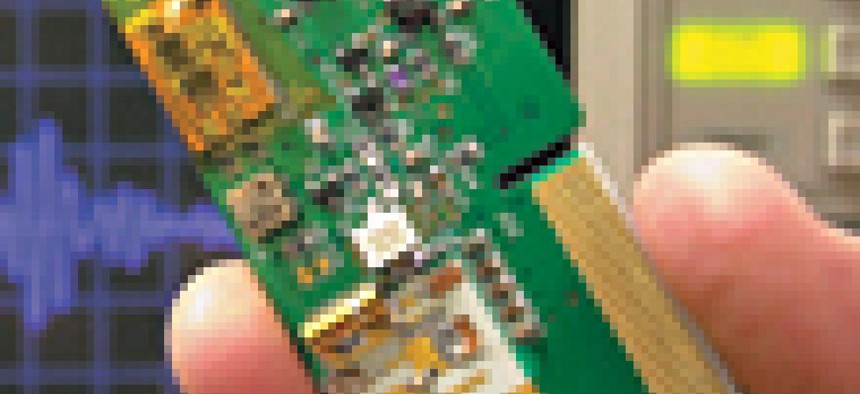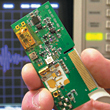Ultra wideband steps forward

On Valentine's Day, ultra wideband equipment vendors were given a sweet present from the Federal Communications Commission: large swaths of spectrum.
On Valentine's Day, ultra wideband equipment vendors were given a sweet present from the Federal Communications Commission: large swaths of spectrum. The commission's board of directors Feb. 14 unanimously voted to allow certain swatches of radio bandwidth to be used for this new communications technology. The nine gigahertz of free spectrum made available to industry is "unprecedented for the FCC," said Robert Fontana, president of Multispectral Solutions Inc., Germantown, Md."For us, getting FCC approval is the same as a pharmaceutical company getting approval from the [Food and Drug Administration] to market a drug," said Ralph Petroff, chief executive officer of Time Domain Inc., Huntsville, Ala. In essence, the commission gave the go-ahead for companies developing ultra wideband technologies to market their products, albeit tentatively. The commission will revisit the ruling in six months to a year, after it has tested the technologies to ensure they don't interfere with other wireless communications, according to FCC spokesman Julius Knapp. In the meantime, companies will refine prototypes for secure high-speed wireless networks, collision avoidance sensors for cars, inventory tracking tags, detectors to find people or objects behind walls or underneath rubble and other uses previously too costly or technically impossible. If the commission imparts a full blessing, the markets these products engender will crack open.The good news for integrators and government-funded research companies is they may already have a leg up in these markets, thanks to early stage government support in developing ultra wideband systems.While the FCC regulates the U.S. spectrum for commercial bodies, the Commerce Department's Telecommunications and Information Administration is in charge of government space and has been allowing agencies to test the technology for some time. Consequently, federal agencies and their contractors, particularly those that are defense-related, have been both working out the kinks of ultra wideband systems and understanding the needs of potential government clients.Last November, CACI International Inc., Arlington, Va., won a $5.7 million contract with the Office of Naval Research to develop a prototype container tracking system for the Navy's Automatic Identification Technology Support Facility in St. Inigoes, Md.Called Geotrack, this program will place ultra wideband-embedded tags on 1,200-pound containers of Freon and other environmentally sensitive packages. The tags will report the location and contents of these packages, as well as the surrounding environment, such as temperature and humidity.The transmitter technology was developed by Time Domain. Cytec Corp., Jackson, Miss., will provide hardware support.Ultra wideband is the "perfect application for this congested environment," said Russ Tice, CACI program manager for the Geotrack program, noting the 4,700 metal Freon containers would confuse signals sent by traditional wireless systems. CACI will build off this work to pursue other military projects in automatic identification technology, according to Tice, who said the number of potential applications is "mind boggling." "The military has amassed so many materials, they need a solution just to keep track of them all," he said.In its offices, Multispectral Solutions keeps a demonstration room for prototypes of ultra wideband systems it has developed. One prototype system is an object tracking device. A laptop shows a 3-D rendering of the floor space of the Multispectral offices. Scattered across the rendering are red and green dots. They represent the locations of coaster-size metal discs scattered through the office, each embedded with an ultra wideband transmitter. When one of the discs is moved, its icon moves on the laptop screen as well.This project was done for the Navy, Fontana said. The service wanted a way to keep track of medical equipment in its hospitals. Expensive items, such as electrocardiogram machines, are often misplaced, "left in a closet somewhere," Fontana said. This requires the Navy to buy more than it needs as backups. Multispectral's tracking system also can track inventory, even the whereabouts of doctors and nurses, he said. Another laptop and receiver combination works as a prototype for an identification system. On military bases today, when a car approaches a gate, the driver must stop and the guard must visually check the person's identification card. With a transmitter and chip encoded with driver information installed on the automobile, that data can be picked up by a guard electronically as the vehicle approaches. To demonstrate, Fontana held a transmitter-embedded device up to a receiver; an identification record appeared on the laptop, complete with picture. Other potential ultra wideband prototypes the company has built include remote control for unmanned aerial vehicles, collision avoidance systems for automobiles and wireless intercom systems, Fontana said. Much of the work was funded by government research and development investments. Time Domain's Petroff said he envisioned ultra wideband being used to replace many of today's computer cables and even wireless computer networking standards, such as Bluetooth. "Ultra wideband is Bluetooth on steroids. With Bluetooth, you may get a half a megabit throughput. With ultra wideband, you'll get 100-plus megabit throughput," Petroff said. He envisions ultra wideband-enabled video cameras streaming their images directly to televisions or computers and CD players sending music to wireless speakers throughout a house.Government-specific applications might include keeping tabs on the environmental conditions in warehouses and jamming- and eavesdropping-resistant radios for combat communications, Petroff said. Both Time Domain and Multispectral agree the best applications still haven't been invented. "If the history of technology tells us anything, the killer application for this technology is something we haven't even thought of yet," Petroff said.Still, much work remains. One hurdle is cost. Petroff said his company will seek to become the Intel of this wideband world, supplying chips for original equipment manufacturers and integrators to build around. But it must beat the costs of competing technologies, such as Bluetooth. To this end, the company is working to reduce the cost of its chip to $10 per unit.A bigger hurdle is full commission approval. While generous with its allotment ? which fell mostly between the 3.1 and 10.6 gigahertz range of the radio frequency spectrum ? the commission showed some hesitancy over the new technology by keeping it away from popular frequencies reserved for global positioning systems, the newly emerging satellite radio market and third-generation wireless systems, even though advocates claim wideband interference would be negligent in those ranges.XXXSPLITXXX-Ultra wideband is a novel type of radio-wave communications that can transmit data over short distances with more flexibility than other radio frequencies. Radio signals that are now used are modulated onto sine-shaped waves. Ultra wideband signals are small pulses of energy, averaging a few nanoseconds each. A digital signal is transmitted by staggering the expected cadence of the pulses. Since these pulses are so short in duration, they occupy a wide range of frequency, hence the name ultra wideband.Because this technique uses very little power, ultra wideband communications can take place under the noise floor of spectrums used by other, higher-powered devices, such as cell phones and global positioning systems. Advocates claim ultra wideband signals won't interfere with these devices. The Federal Communications Commission has preliminarily agreed with this hypothesis, though it is doing more testing. As a communications tool, ultra wideband could be used to build high-bandwidth local wireless networks to support many more hosts than other wireless protocols, such as Bluetooth and 802.11b, could carry without confusion. Ultra wideband networks also could be used in areas too obstacle-laden for other wireless protocols to work in. And because ultra wideband signals are so widely spaced, they are very resistant to jamming and eavesdropping, leading to more secure wireless communications. Ultra wideband pulsed signals also can be used to make extremely precise measurements of remote objects, paving the way for more accurate and lower-cost radar, imaging and other object-detection devices.

Staff Writer Joab Jackson can be reached at jjackson@postnewsweektech.com.

This ultra wideband transceiver, made by Multispectral Solutions, Inc., closely tracks movements of nearby objects.
Staff Writer Joab Jackson can be reached at jjackson@postnewsweektech.com.

